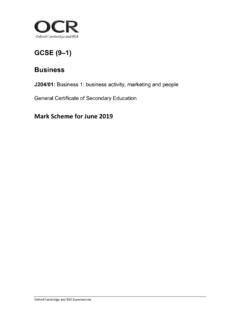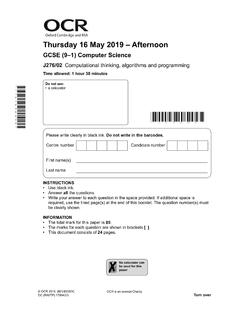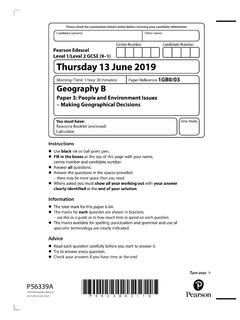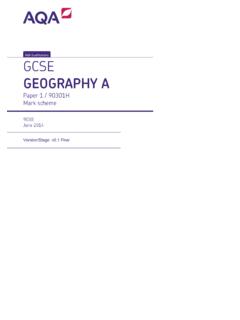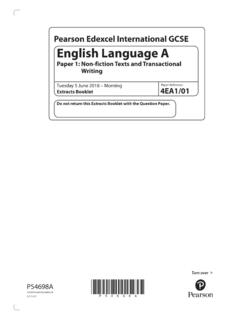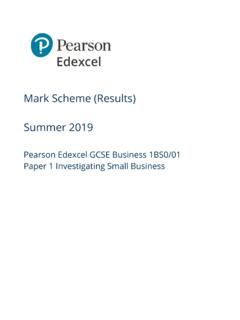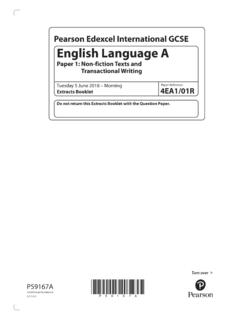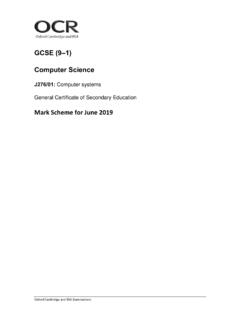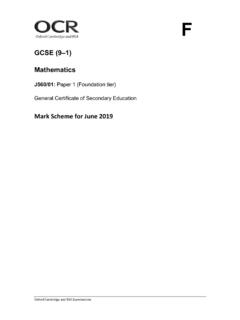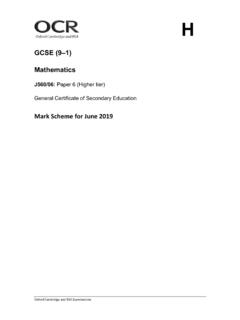Transcription of H555/01: Physiological factors affecting performance ...
1 Oxford cambridge and RSA Examinations GCE Physical Education H555/01: Physiological factors affecting performance Advanced GCE Mark Scheme for June 2019 OCR (Oxford cambridge and RSA) is a leading UK awarding body, providing a wide range of qualifications to meet the needs of candidates of all ages and abilities. OCR qualifications include AS/A levels , Diplomas, GCSEs, cambridge Nationals, cambridge Technicals, Functional Skills, Key Skills, Entry Level qualifications, NVQs and vocational qualifications in areas such as IT, business , languages, teaching/training, administration and secretarial skills. It is also responsible for developing new specifications to meet national requirements and the needs of students and teachers. OCR is a not-for-profit organisation; any surplus made is invested back into the establishment to help towards the development of qualifications and support, which keep pace with the changing needs of today s society.
2 This mark scheme is published as an aid to teachers and students, to indicate the requirements of the examination. It shows the basis on which marks were awarded by examiners. It does not indicate the details of the discussions which took place at an examiners meeting before marking commenced. All examiners are instructed that alternative correct answers and unexpected approaches in candidates scripts must be given marks that fairly reflect the relevant knowledge and skills demonstrated. Mark schemes should be read in conjunction with the published question papers and the report on the examination. OCR 2019 H555/01 Mark Scheme June 2019 1 Annotations used in the detailed Mark Scheme Annotation Description Annotation Description Tick Knowledge and understanding / indicates AO1 on Q9 Cross Example/Reference / indicates AO2 on Q9 Benefit of doubt Development / indicates AO3 on Q9 Too vague Level 1 response on Q9 Repeat Level 2 response on Q9 Indicates sub-max reached where relevant Level 3 response on Q9 Noted but no credit given Level 4 response on Q9 Significant amount of material which doesn t answer the question Blank page Sub-maxes are indicated with S.
3 The guidance section of the mark scheme shows which questions these are relevant to. KU/EG/DEV used instead of ticks on the extended response question to indicate where knowledge or development points from the indicative content have been made. On this extended response question, one KU/EG/DEV does not necessarily equate to one mark being awarded; the marking is based on a levels of response mark scheme which awards a level and mark holistically based upon the quality of the response overall against the levels descriptors. H555/01 Mark Scheme June 2019 2 Section A Question Answer Marks Guidance 1 Two marks from: 1. Increased heart rate/ cardiovascular drift 2.
4 (vaso)dilation of arteries/arterioles to skin or increased blood flow to skin 3. decreased blood volume/cardiac output or increased blood viscosity or reduced plasma volume 4. decreased stroke volume 5. decreased venous return 6. reduced oxygen/oxygenated blood to muscles 2 (AO1) Mark 1st 2 only 2 Two marks from: Goniometry Sit and Reach 1. (Equipment) (360o) protractor sit and reach uses box/bench and ruler 2. (Method) measure joint angle/ degrees Measures distance of reach/ cms 3. (Where) any joint/ planes of movement back/hamstring/leg/hip flexibility 4. (Assistance) Requires assistance Can be performed on own 5. (Validity) Goniometers more sport-specific/ accurate/ preferred/ require more training 6. (Cost/time) Both methods are cheap/quick 2 (AO1) Must compare tests for each mark or use comparative language for pt 5/6.
5 Do not accept: simple/easy (TV) 3 Two marks from: 1. (100m swim) lactic acid system/ glycolytic system/ anaerobic glycolysis 2. (gym vault) ATP-PC/ PC system/ alactic system 2 (AO2) Do not accept: ATP/ glycolysis 4 Two marks from: 1. (second class) calf raise or take-off phase of high jump at ankle 2. (third class) bicep curl or knee extension when kicking a ball 2 (AO2) Do not accept: Whole body examples, javelin throw/ long jump take off Reference to a specific location/joint required for example 5 Two marks from: 1. wind tunnels 2. limb kinematics 2 (AO1) H555/01 Mark Scheme June 2019 3 Section B Question Answer Marks Guidance 6 (a) Three marks from: 1.
6 (Nerve) impulse/stimulus (from brain/spinal cord/CNS) travels down the axon/motor neuron 2. Action potential 3. Release of sodium/NA+ (ions) causes depolarisation 4. (at neuromuscular junction) neurotransmitter/acetylcholine/ACh is secreted/transmits impulse 5. impulse crosses synaptic cleft/gap to muscle fibres/motor unit/motor end plate 6. If the impulse/stimulus/charge/action potential is above threshold 7. all muscle fibres in motor unit will contract (or not at all) or all or none law applies 3 (AO1) accept synapse for synaptic cleft/gap (BOD) (b) Five marks for: 1. A extension or no change/movement 2. B isometric/static or concentric (only if extension stated in A) 3. C hinge 4. D plantar flexion 5. E gastrocnemius/soleus 5 (AO2) If A = no change If B = do not accept concentric (X) (c) (i) Five marks from: 1.
7 ATP-PC or alactic or PC system 2. PC breakdown releases energy or high energy bond is broken or PC P + C + energy 3. Energy used to resynthesize ATP/ energy + ADP + P ATP 4. Using coupled reaction/ exothermic and endothermic reactions 5. (reaction) anaerobic/without oxygen 6. (enzyme) creatine kinase 7. (site) sarcoplasm or cytoplasm of muscle cell 8. (yield) 1 ATP per PC/ 1:1 energy yield 5 (AO1) Do not accept: breakdown of ATP (c) (ii) Three marks from: 1. Quick or simple reactions or PC breaks down easily or fast ATP resynthesis 2. Provides energy for high-intensity activities/speed/power/explosive strength 3 (AO3) H555/01 Mark Scheme June 2019 4 Section A Question Answer Marks Guidance 3.
8 No delay to wait for oxygen 4. No fatiguing by-products 5. Quick/fast muscle phosphagen/PC recovery or only 30s for 50%/ 2-3min for full recovery 6. limited stores of PC or stores are exhausted quickly or only lasts 8-10 seconds 7. Only 1 ATP per PC or low yield or inefficient (d) Four marks from: 1. EPOC restores PC/phosphagen/ATP/oxy-myoglobin and removes lactic acid 2. Warm up to reduce oxygen deficit/increase blood flow/oxygen to muscles/delay OBLA 3. Cool down/active recovery to speed up removal of lactic acid/maintain elevated respiration/circulatory rates/maintain blood flow 4. (Reduce EPOC by) monitoring intensity of training to delay OBLA 5. Include breaks to allow 30s 50%/2-3mins (full) PC restoration or work:relief ratio of 1:3+/ full recovery when training ATP-PC system/during speed/sprint work 6.
9 Active recovery between intervals/work:relief ratio of 1:2/partial recovery when training lactic acid/glycolytic system 7. Use of cooling aids/ice baths to speed up recovery/reduce EPOC 4 (AO2) Do not accept: WU/CD on own (TV) Explanations of key points required 7 (a) (i) Four marks from: 1. Increase HR/SV/Q to increase O2/blood flow/ reduce O2 deficit 2. Vascular shunt/vasodilation to increase blood flow to muscles 4 (AO1) Do not accept: prevent injury H555/01 Mark Scheme June 2019 5 3. Increase RR/TV/VE to increase volume of O2 in lungs/ for gaseous exchange 4. Increase elasticity of muscles/connective tissue to reduce risk of injury/ DOMS/ increase speed/force of contraction 5.
10 Activate neural pathways/ speed up nerve transmission 6. Increase enzyme activity 7. Improve recruitment/synchronisation of motor units 8. Improved O2 utilisation/ haemoglobin release O2 more easily (a) (ii) Four marks from: (positives - sub-max 3) 1. Reduce (core body) temperature/sweating/ delay overheating/ prevent dehydration/ early fatigue in hot environments/ heat stroke 2. Reduce thermal strain 3. Reduce cardiovascular drift 4. Causes vasoconstriction to reduce blood flow 5. Treat injuries to reduce pain/swelling/inflammation 6. (after use) vasodilation/increases blood flow to aid healing/repair/removal of LA/speed recovery/reduce DOMS (negatives sub-max 3) 7. Hard to perceive exercise intensity/can lead to over-exertion 8. Can mask/complicate injuries 9.
